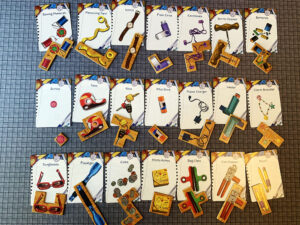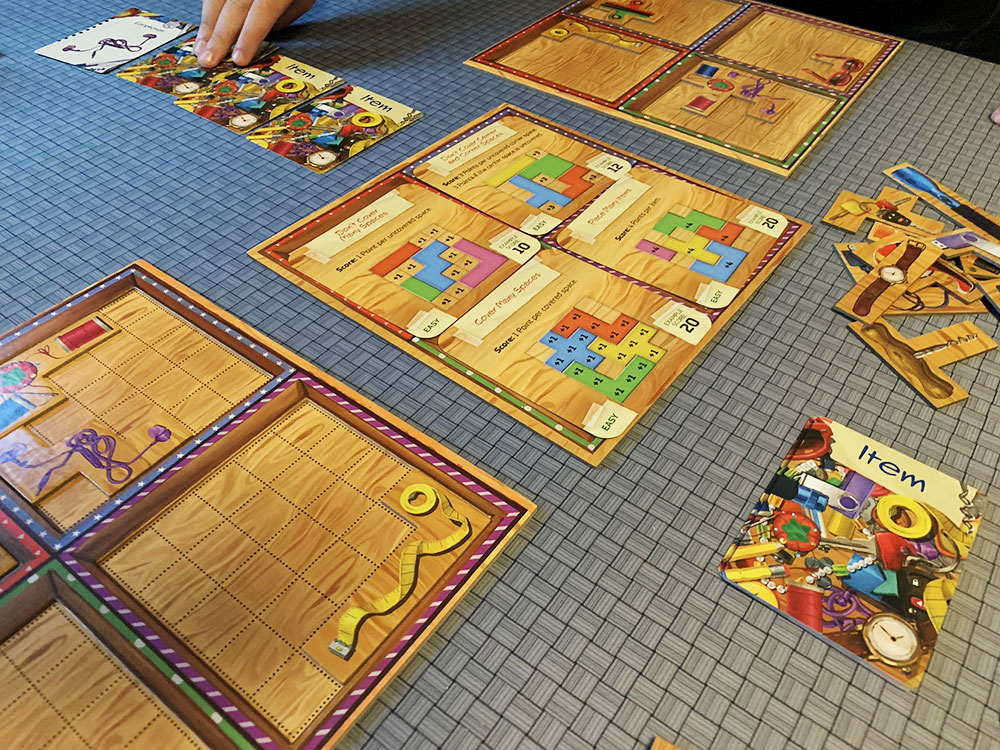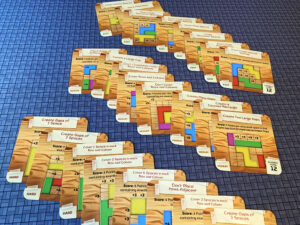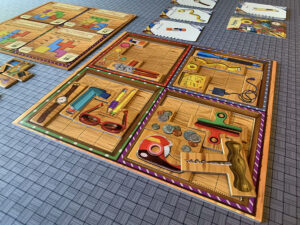 Americans love their stuff. There’s a whole industry set up to hold the stuff that doesn’t fit in your home. There’s even a company that makes storage units that can be delivered so you don’t have to transport the stuff you plan to store off-site.
Americans love their stuff. There’s a whole industry set up to hold the stuff that doesn’t fit in your home. There’s even a company that makes storage units that can be delivered so you don’t have to transport the stuff you plan to store off-site.
But, no matter how much decluttering someone does, there will always be one (or more) drawers that just hold all those things that you need so you can’t box them up and send it to Public Storage or too small to justify doing so. Those items get tossed in the junk drawer and today we’re going to judge each other’s organizational skills while playing the game Junk Drawer by David Smith with art by Asha Farmer and published by 25th Century games.
Junk Drawer is a 1-4 player game where you’re trying to get your organization on in your junk drawer by playing polyominos onto your player board and scoring the most points by probably not filling your drawer.
Gameplay Overview:
At the start of the game four organizational goal cards are placed on a board in the center of the table with colored borders representing each of the four containers in your junk drawer. There are Easy, Medium, and Hard cards to choose from and these set the scoring for each of the four compartments you’re organizing. To start a round, lay out four item cards face down.

These goal cards will score points for things like having the edges filled, not touching the edges, or having specific gaps. Each one shows an example making it easy to decipher.
Each turn, flip the first face-down card which shows an item. Each player places that polyomino in one of the areas of their junk drawer player board. The rules for placement is it can not overlap any other item or the edge of the area. Additionally, you can only place one item per round in each quadrant, evenly distributing your stuff, by quantity.
This means after the first round each of your quadrants has one item in it, and then two in each after the second round, etc. When someone can’t place an item, that becomes the last item played and everyone’s boards are scored with the highest scoring player winning.
There is a variant that allows other players to keep playing after the first player taps out even starting new rounds until nobody can continue playing. Additionally, there’s a beat your own score solo mode using five sets of selected goal cards that has a single player trying to beat the sample scores on the various goal cards.

Junk Drawer
Game Experience:
I was surprised at how short games of Junk Drawer run and that is both a blessing and a curse. Where I love it is sometimes, between dinner, my kid doing his homework, my kid procrastinating doing his homework, my writing reviews, and procrastinating writing reviews, there’s often not a lot of time left over to play a game together and that’s where Junk Drawer fits in fantastically. And you still feel like you have to make some decisions with every item drawn. Everyone playing simultaneously keeps the game moving along and everyone engaged.

But this is also a game that goes from “this is a cake walk” to “whelp, I’m done” in about three full turns which can feel anticlimactic in its abrupt ending. And whether that quick escalation is a good or bad thing will vary. Once I understood that this played as snappy as it does, I was at peace with it while my first play did leave me questioning, “that’s it?”
Strategically, going for maximum points early on may result in you unable to place a tile as quickly as the next turn which ends the game. But you can also aim for the swift win by using that strategy and therein lies a mild concern with the game. My previous choices in the game might have me end the game early and there’s no penalty for that.
Meanwhile in a game like Sagrada, not being able to place a die gives negative points. There is a variant that allows for players to continue until they can’t place any more items, essentially eliminating players as the game progresses. But some goal cards will automatically score less with each passing round making the variant to allow players to continue not always beneficial to them. I’m not usually a fan of player elimination but in this case, the games tend to be short enough it’s not an issue.

In the games I’ve played, I’ve been the first one out about half the time due to trying to maximize scores in each quadrant which left me vulnerable to some shapes. Unlike most endurance events, dropping out first doesn’t seem to be a deciding factor in winning or losing but there’s some goal cards that favor an earlier exit than other ones which allows for another layer of strategy to plan for as an off-ramp.
The other negative is the games do feel pretty samey after a while with many of the 24 goal cards being variants of one another (for example: don’t fill the perimeter and fill the interior). These do score differently, but you’re still aiming for similar shapes. Meanwhile, while not bringing anything new to the gameplay, the solo mode goes from elementary school to graduate school in one step so there are some challenges there if you’re looking for a beat-your-own-score solo mode.
Final Thoughts:
This isn’t going to be an evergreen for most deep-into-the-hobby gamers but I think it could work for some people with it’s pretty accessible theme and a quick playtime. The upside of this game is how light and easy it is to teach to anyone. This is a great gateway game to introduce polyominos to non-gamers and is easier than both Patchwork and Barenpark to teach. And while I do prefer those both to Junk Drawer, I can’t play those in 15 minutes and that’s a huge plus for me and my busy family. Now, excuse me while I get back to procrastinating.
Final Score: 3 Stars – Junk Drawer is a light, easy-to-teach and quick-playing game that has you placing polyominos, feeling good about your choices, and then regretting that same decision a few minutes later.
 Hits:
Hits:
• Easy to teach
• Plays in 15-20 minutes
• Simultaneous play keeps everyone engaged
Misses:
• Can be very samey game to game
• No penalty for not placing that last tile
• Variant to continue playing may not benefit remaining players





















